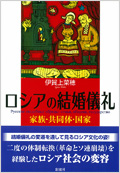Top>Opinion>Brides Crying at Weddings: A Similarity between Wedding Receptions in Contemporary Japan and Peasant Rituals in Imperial Russia
 Index
Index

Naho Igaue [profile]
Brides Crying at Weddings:
A Similarity between Wedding Receptions in Contemporary Japan and Peasant Rituals in Imperial Russia
Naho Igaue
Associate Professor, Faculty of Policy Studies, Chuo University
Areas of Specialization: Cultural Anthropology (Ethnology), Russian History
Brides’ Letters at Wedding Receptions
A value system regarding family members and relatives, which people are usually not very aware of, emerges in wedding ceremonies. When I attend Japanese weddings, the part that interests me as a researcher of Russian ethnology is that the Japanese bride reads out a letter at the wedding reception. Japanese weddings vary widely from region to region and person to person, so I know there are cases where this presentation is excluded. But from the looks of Tokyo bridal magazines, it seems that people still consider it a routine part of the reception.
Presumably, the main attraction or way for the bride to shine during this presentation is her tears. The letter is directed at various people, including the groom, but the voices of many brides break with emotion when they express their gratitude to their parents. The invited guests also get misty-eyed at the sight of the bride’s parents tearing up as they listen, and a quiet, heartfelt mood pervades the hall.
Thus, the bride’s letter is one of the climaxes of the reception. At the same time, however, some express concerns and objections regarding the shedding and viewing of tears at receptions. It seems there are some brides who avoid this presentation because they don’t want to show their tears.
On the one hand there are people who think the bride’s tears are an inseparable part of a wedding, while on the other hand there are many brides who do not cry. In this article, I would like to consider issues surrounding the bride’s tears, comparing this practice with another example somewhat far-removed from Japan—the peasant wedding rituals of Russia.
The Culture of Mourning in Russia
My preoccupation with brides’ tears can be influenced by the research I have done on Russian wedding rituals. This is because brides in rural Russia started singging “laments” when their marriage was decided.
“Laments” (prichitaniya) or “keenings”, which are called Nakiuta or Banka in Japanese, are generally sung at funerals. While Chinese and Korean cultures of ritually “crying/wailing” in remembrance of the dead are well-known, these cultural practices have also spread into other regions. A culture of mourning and the existence of nakime (female mourners) supporting this culture can be found in the Kojiki (“Record of Ancient Matters”), Japan’s oldest extant history book.
A culture of mourning has also been known for a long time among the Russians. It is not just loud weeping but has developed as songs expressing the worldview of the mourner. The culture of mourning quickly fell out of use among Russia’s upper classes, and was “discovered” as a folk tradition in the 19th century. At this time, the laments of the peasants evolved independently, and they sang them in various contexts besides funerals, such as conscription into the military, natural disasters, and weddings.
The Meaning behind Laments during Wedding Rituals
It is easy to understand the reasons for singing laments during funerals, conscription and natural disasters. People grieve over misfortune and separation at these times. Similarly, at weddings the bride sang about her “unhappiness” at leaving behind her happy maidenhood, parting with her parents, and “marrying into another family.”
A young woman who had been betrothed would stay indoors until the day of the wedding, secluded in the kitchen with her friends, and sing with emotion about her unhappiness at having to leave behind the joyful days of her maidenhood. For once she married, she would be separated from her kind parents and forced to do hard work by her in-laws. Once she became a married woman, her maiden “beauty” that had attracted young men would fade away, and she would live out her days crying…
Russian wedding laments are so filled with sorrow that one starts to wonder why the bride doesn’t just call off the wedding. However, failing to get married was actually seen as the ultimate unhappiness for a woman in Russian villages at the time. The inevitability of marriage was repeatedly emphasized in the laments as well. Then, on the day of the wedding, after the bridegroom took the hand of the bride and the marriage was complete, the laments ceased.
These days, Japanese people would find it strange to sing laments derived from funeral rites at the happy occasion of a wedding. However, as is well known in cultural anthropology and ethnology, the “death of the bride” has been frequently portrayed symbolically when a woman “marries into” the bridegroom’s family (virilocal marriage), leaving her parents’ home and going to live with her husband. The idea is that the woman’s life as a daughter ends, and she is reborn as a wife and daughter-in-law. In some parts of Japan as well, the bride’s rice bowl used to be smashed at the front door when she left, as if to say she could not return to her parents’ home; the same ritual was performed during funerals so that the deceased would not return home.
Incidentally, Russian wedding laments were criticized during the Soviet era as a “strange” practice of forcing happy brides to cry, and the practice died out in many parts of Russia by the 1960s. I have not seen any tearful brides at the modern Russian weddings I have attended.
A Declaration of Independence or “Marrying into the Bridegroom’s Family”?
When we turn back to contemporary Japan and recall the tears of Japanese brides, we find that the bride’s separation from her parents at marriage is emphasized here as well. As she reads the letter, is the bride trying to point out that “independence from one’s parents”? Or is she expressing that she has married into the bridegroom’s family and become the member of another family”? The answer may vary from person to person.
Even so, the bride’s presentation of her letter, as a whole, conjures up an image of the latter, that is, the separation of the bride from her family due to “marriage into the bridegroom’s family.” At one time (possibly even now?), Japanese movies and TV dramas would frequently include a scene where the bride leaving her family home would kneel with both hands on the floor before her parents and refer to the separation by saying, “Thank you for everything,” as her eyes filled with tears. The overlap between the crying brides at contemporary wedding receptions and these scenes is apparent to the generations of people who are familiar with them.
Moreover, the rarity of bridegrooms reading out their own letters of gratitude to their parents in wedding receptions today, or the asymmetry in the behavior of brides and grooms, increases the impression that it is just the bride who is parting with her parents. Russian laments were also only sung by the bride’s side of the family.
When one looks online, it appears that the number of bridegrooms who read letters is increasing in Japan today. It also seems there are bridegrooms and parents of the bridegroom who shed tears. However, negative opinions are often expressed regarding “tears on the bridegroom’s side of the family,” except in cases where guests know that he or his family have overcome major difficulties in their lives. In this sense, the asymmetry between the bride and bridegroom has not been resolved.
Only the bride says goodbye to her parents, and this moment is frequently accompanied by tears. The fact that this scene is expected in weddings and felt to be “natural” and “beautiful” is proof that there is still a strong sense in Japan that “marriage means marrying into/taking a wife into the bridegroom’s family.” Weepy brides and bridegrooms cannot even cry in peace if they do not know what the guests will think of their tears.
- Naho Igaue
Associate Professor, Faculty of Policy Studies, Chuo University
Areas of Specialization: Cultural Anthropology (Ethnology), Russian History - Naho Igaue was born in Matsuyama, Ehime Prefecture in 1969. She holds a Ph.D. in Language and Culture from Osaka University. She graduated from the Department of Russian Studies, Faculty of Foreign Studies, Sophia (Jochi) University in 1992. She completed the master’s program at the Graduate School of Language and Culture, Osaka University in 1994, as well as the doctoral program at the same school in 2001. After working as a lecturer (research fellow) at the Center for Northeast Asian Studies, Tohoku University, an assistant at the Graduate School of Language and Culture, Osaka University, and a part-time lecturer at the same university, she assumed her current position in 2009. She is currently researching Russian rural culture, its religious situation, and various issues related to ethnic Russians resident in former “Manchukuo”. Her major publications include Russian Wedding Rituals [Roshia no Kekkon Girei] (Sairyusha, 2013) and The Communities and Lives of Russians in Manchuria [Manshu ni okeru Roshiajin no Shakai to Seikatsu] (co-authored, Minerva Shobo, 2013).
- Research Activities as a Member of Research Fellowship for Young Scientists (DC1), Japan Society for the Promotion of Science (JSPS) Shuma Tsurumi
- Important Factors for Innovation in Payment Services Nobuhiko Sugiura
- Beyond the Concepts of Fellow Citizens and Foreigners— To Achieve SDGs Goal 10 “Reduce Inequality Within and Among Countries” Rika Lee
- Diary of Struggles in Cambodia Fumie Fukuoka
- How Can We Measure Learning Ability?
—Analysis of a Competency Self-Assessment Questionnaire— Yu Saito / Yoko Neha - The Making of the Movie Kirakira Megane









